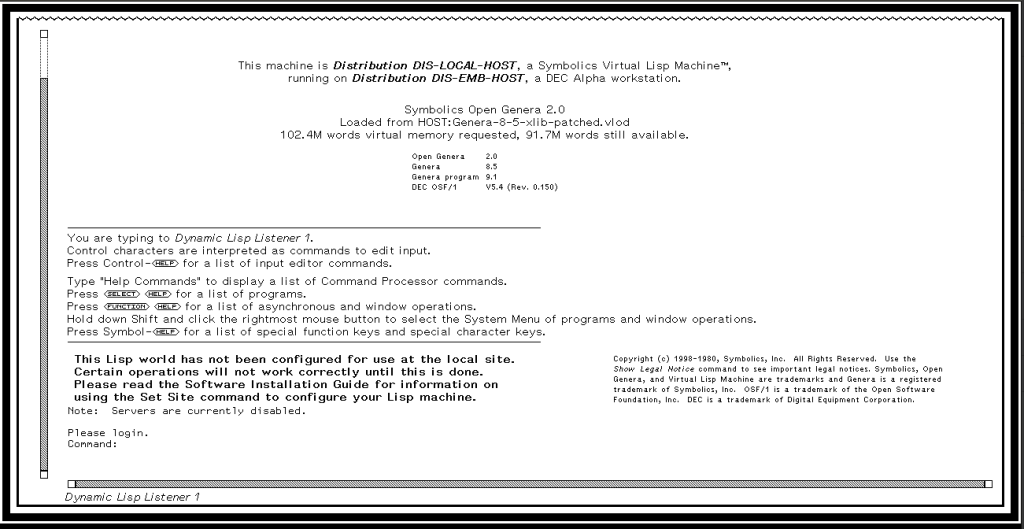Posted on August 16, 2024
Running OpenGenera on Linux(Revised)

This is a guide for those who are either beginners or intermediate in Linux knowledge. Comfortability with the command line, compiling and virtual machines.
As the guide from 2018, linked here, is a little out of date, I’m going to instead run you through a better way to run opengenera even if you have never worked with VLM. However, I do expect the reader to have a solid foundation in computer and virtual machines. There are other guides online that will allow you to learn what I gloss over here. I have no idea what the original author did to compile the binaries on his page, but do not use them unless you are advanced in packaged debugging. Both of his compiled binaries failed to load on my test system with a Ryzen CPU. That is beyond the scope of this write up. I will also make the instructions a little clearer and explain what each one does.
That being said, you should be able to compile VLM on any modern x64 based system. As long as you have a compatible GCC compiler, your Linux distro choice is up to you. I went with Ubuntu 18.04 for ease of use and compatibility with x.org. If you want to build a bash script that loads on Wayland, that is also out of the scope of this document.
After you have setup your virtual machine with the options you want, you should start with an open terminal window. If you are unable to setup a virtual machine I would recommend you read the documentation and learn. You’re going to want to source a modern working VLM to run your genera world file. I used this one full of plenty of bug fixes(as of late 2024). The repository can be either git cloned or downloaded normally, depending on your workflow. The compiling instructions are in the INSTALL file in the repository, but as per normal you’re going to want to install gcc make before you build. The build will also require a few more dependencies, these can be installed prior to building, or after a failed build like myself.
sudo apt install gcc make (gcc is the compiler and make is the tool to build executables)
sudo apt install sbcl (this is common lisp, the language used in genera)
sudo apt install libx11dev (a X Window System protocol client library)
sudo apt-get install xcb libxcb-xkb-dev x11-xkb-utils libx11-xcb-dev libxkbcommon-x11-dev(xcb is a library implementing the client-side of the X11 display server protocol, libxkb is a keyboard handling library, others are supporting libraries and tools for each)
Some of these packages might be extraneous, however I find that It’s better safe than sorry with dependencies. You would allow it to finish and then run the commands in the linux-vlm repo. There is plenty of troubleshooting for building the executables in the INSTALL file. Unless you specify otherwise, the genera executable will end up in /usr/local/bin. You are welcome to move it from this folder, but I chose not to as this virtual machine was only built for emulating genera so it’s only going to have a mess of other files in there. If you chose to make a directory in $HOME, make sure to move the genera executable to that folder.
Now we can move gears back to the original post and collect the world and debugger files available online. Should these ever be removed, I will update this post with the current source of files. The following commands are going to be run in the directory that has the genera executable
curl -L -O https://archives.loomcom.com/genera/worlds/Genera-8-5-xlib-patched.vlod
This command downloads the “world” file- the Lisp machine saved to disk- think of it as a virtual box disc with a preinstalled OS
curl -L -O https://archives.loomcom.com/genera/worlds/VLM_debugger
This is your VLM Debugger.
curl -L -O https://archives.loomcom.com/genera/worlds/dot.VLM
This is your config file for VLM. I would recommend editing it before you move it, as the moving process tosses it in a hidden folder.
Next, you are going to want to either open a separate terminal window, or move to a different directory one the open one. From your current working directory, you are going to need to toss this command to switch to a directory in your /var folder-which holds your variable files-files that change while the operating system is running.
cd /var/lib
Once in this directory you’re going to need to download the var_lib_symbolics tarball.
sudo curl -L -O https://archives.loomcom.com/genera/var_lib_symbolics.tar.gz
and untar it
sudo tar xvf var_lib_symbolics.tar.gz
Once that is done you are going to need to change permission to the user that will be using the VLM. I am going off the assumption that the user is UID 1000 and GID 1000, but please double check your values by simply typing id in the terminal
sudo chown -R 1000:1000 symbolics
Heading back to the original directory, you need to edit the dot.vlm file. I personally use nano, but vi is acceptable too
sudo nano dot.VLM
once in the editor you’re going to need to change the
“genera.worldSearchPath: /home/seth/genera” to
“genera.worldSearchPath: /path/to/directory“. In my case, it was /user/local/bin as that’s where the VLM executable was dropped and where I curled all the files to originally. Unless you want to work with different *internal* IP addresses for genera exclusively, you can leave all the other options alone, and save and close the file. Once closed you can move it to the hidden directory.
mv dot.VLM .VLM
The next bits are manually setting up hosts, time&daytime services, nfs and the tap0, all needed for old UNIX operating systems, but modern linux has no need for them anymore. We are going to download them in any order as long as you do every option.
The Hosts File
You need to setup the hosts file to match the internal network that the VLM needs. These can be changed, but for the sake of simplicity , I am going to leave them exactly what they were in the dot.VLM conf.
sudo nano /etc/hosts
In this file you’re going to add two entries exactly as follows
192.168.2.1 genera-vlm
192.168.2.2 genera
write to disk and exit.
Time and Daytime Services
Genera uses the old time and daytime unix facilities to set its clock. They must be installed and configured.
sudo apt install inetutils-inetd
Now you’ll need to edit the configuration file for use.
sudo nano /etc/inetd.conf
You’re going to want to replace the contents, or just add if all the information is commented out.
time stream tcp nowait root internal
time dgram udp wait root internal
daytime stream tcp nowait root internal
daytime dgram udp wait root internal
Then restart the service
sudo systemctl restart inetutils-inetd.service
You can check if this worked by using telnet on localhost 37 or 13. It is normal for the connection to close the service.
NFS Services
Genera is going to need to access files on the local host, and this would be the most simple service to use. You can install NFS with the following command.
sudo apt-get install nfs-common nfs-kernel-server
You will also need to edit the NFS configuration file. This guide is going to assume you are using Ubuntu so you can use the following line without editing. Adjust your anonuid and anongid if on a different user account or distro.
/ genera(rw,sync,no_subtree_check,all_squash,anonuid=1000,anongid=1000)
Make sure the above lines are on the same line in the conf file, and space in between / and genera. Then restart the service
sudo systemctl restart nfs-kernel-server
You are welcome to check if the filesystem has been exported correctly use the following line, or else move on.
sudo exportfs -rav
You also need to edit another nfs configuration file to tell NFS to use V2, in this case anything after Ubuntu 17.04. This guide is assuming you are running 18.04 so this is also required.
sudo nano /etc/default/nfs-kernel-server
You’re going to need to change these two lines
RPCNFSDCOUNT=8
RPCMOUNTDOPTS=”–manage-gids”
to
RPCNFSDCOUNT=”–nfs-version 2 8″
RPCMOUNTDOPTS=”–nfs-version 2 –manage-gids”
Then restart the service.
sudo systemctl restart nfs-kernel-server
Creating the tap0 interface
sudo apt install uml-utilities
Edit the interface file
sudo nano /etc/network/interfaces
Then add the following lines to /etc/network/interfaces
auto tap0
iface tap0 inet static
address 192.168.2.1
netmask 255.255.255.0
pre-up /usr/bin/tunctl -t tap0
If this method fails to work for you, you can manually do this on every reboot of the VM
sudo ip tuntap add dev tap0 mode tap
sudo ip addr add 192.168.2.1/24 dev tap0
sudo ip link set dev tap0 up
If all instructions have been followed up to this point you should have a working install of opengenera. you are welcome to start the executable by running
sudo ./genera
from the directory. If you do not run as sudo, then any changes you make in genera will not write to disk when you set settings and reboot VLM
from here you should have a login prompt in a new window for opengenera! Enjoy Lisp!
In the terminal you will type:
